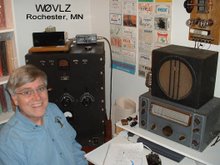I first started on this project over 15 years ago. I wanted a 6L6 based transmitter with a spotting function. Over the years it has gone through several iterations to the "Dingey Size Boat Anchor" I use today. Along the way I added a loading control, regulated the oscillator plate voltage to 108 volts, shifted the output circuit to a pi network and repackaged it in a metal cabinet to better match my HRO Sr. Like many projects it has been a journey. Here are a few more details about this transmitter as it stands today.
The circuit itself is fairly standard using a separate 300 B+ power supply. About the only thing I don't see in most designs is SW, the spotting switch. It allows me to check my crystal frequency against any station I might want to work or against QRM. As an important serendipity it also allows me to run the oscillator continuously while keying only the 6L6 output stage. This cuts down on chirp caused by the crystal restarting at the beginning of each code element. C10, the loading capacitor, is really two capacitors in parallel. One is a typical 300pf variable. The second is a 300pf high voltage "door knob" capacitor that can be switched it/out with a toggle switch.
Coils are what I could find. The 80 and 40 meter coils are commercial Bud coils that I had. I'm using only the tank portion, not the link. For 30 I found an old plug-in coil that looked about right and tried it. It works. In general look for coils that dip and load to around 60% efficiency (ie. 6 to 7 watts output for 10 to 12 watts input).
Inside I arranged everything so that it made sense. Across the back, left to right, is the 6J5 oscillator, the 6L6 final and then the plug-in output coil. Just to the right of the coil is the toggle switch that switches in/out the additional 300pf loading capacity. The crystal socket is near the 6J5 and the 0C3 108 V voltage regulator is just to the right of that.
When changing crystals or, especially, coils it is important to recognize where high voltage is exposed. In this case the unprotected meter terminals have 300 VDC, a lethal voltage, on them. Power this transmitter down when under the covers. This is even more important when working under the chassis. Don't take chances. Power down before working on it. As a safety modification consider placing the crystal socket on the front panel.
Are you looking for something more modern looking? Try W1TS's 6C4-5763 MOPA in the October 1968 issue QST. Just add a resistor and 0B2 to regulate the oscillator B+ to 108V and include a switch to run the oscillator stage while keying the final.
Saturday, February 29, 2020
Subscribe to:
Post Comments (Atom)





No comments:
Post a Comment